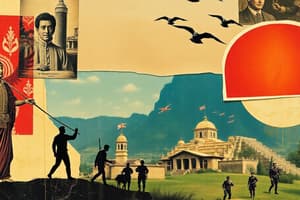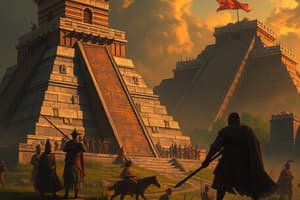Podcast
Questions and Answers
¿Cuál fue el resultado del Tratado de Córdoba en 1821?
¿Cuál fue el resultado del Tratado de Córdoba en 1821?
¿Qué acontecimiento significativo comenzó alrededor de 1910 en México?
¿Qué acontecimiento significativo comenzó alrededor de 1910 en México?
¿Qué líderes lucharon por la reforma agraria y la justicia social durante la Revolución Mexicana?
¿Qué líderes lucharon por la reforma agraria y la justicia social durante la Revolución Mexicana?
¿Cuál fue una característica de México en el siglo XX después de la Revolución?
¿Cuál fue una característica de México en el siglo XX después de la Revolución?
Signup and view all the answers
¿Qué problema enfrentó México después de obtener su independencia?
¿Qué problema enfrentó México después de obtener su independencia?
Signup and view all the answers
¿Cuál de las siguientes culturas mesoamericanas no se menciona en el texto como una cultura significativa?
¿Cuál de las siguientes culturas mesoamericanas no se menciona en el texto como una cultura significativa?
Signup and view all the answers
¿Qué ventaja militar clave tuvieron los españoles durante la conquista de México?
¿Qué ventaja militar clave tuvieron los españoles durante la conquista de México?
Signup and view all the answers
¿Cuál es el nombre del sistema de trabajo forzado que se implementó durante el periodo colonial en México?
¿Cuál es el nombre del sistema de trabajo forzado que se implementó durante el periodo colonial en México?
Signup and view all the answers
¿Cuál fue uno de los recursos más importantes extraídos en Nueva España durante la época colonial?
¿Cuál fue uno de los recursos más importantes extraídos en Nueva España durante la época colonial?
Signup and view all the answers
¿Quién dio inicio al movimiento de independencia de México con el 'Grito de Dolores' en 1810?
¿Quién dio inicio al movimiento de independencia de México con el 'Grito de Dolores' en 1810?
Signup and view all the answers
Flashcards
Era Prehispánica
Era Prehispánica
Período antes de la llegada de los europeos, con civilizaciones diversas como los Olmecas y los Aztecas.
Chinampas
Chinampas
Técnicas agrícolas avanzadas utilizadas por los Aztecas para cultivar en el agua.
Conquista Española
Conquista Española
La llegada de Hernán Cortés en 1519 y la caída del Imperio Azteca en 1521.
Encomienda
Encomienda
Signup and view all the flashcards
Grito de Dolores
Grito de Dolores
Signup and view all the flashcards
Independencia de México
Independencia de México
Signup and view all the flashcards
Tratado de Córdoba
Tratado de Córdoba
Signup and view all the flashcards
Revolución Mexicana
Revolución Mexicana
Signup and view all the flashcards
Emiliano Zapata y Pancho Villa
Emiliano Zapata y Pancho Villa
Signup and view all the flashcards
Desarrollo económico en el siglo XX
Desarrollo económico en el siglo XX
Signup and view all the flashcards
Study Notes
Pre-Hispanic Era
- Mesoamerica boasted diverse civilizations before European contact.
- Notable cultures included the Olmecs, Maya, Teotihuacan, Zapotecs, and Toltecs, each renowned for artistic, architectural, and social accomplishments.
- The Aztecs, distinguished by advanced agriculture (chinampas) and a complex social structure, rose to prominence in central Mexico by the 14th century.
- Aztec society was hierarchical, with a powerful emperor and a complex tribute and religious system.
- Their capital, Tenochtitlan, was a significant urban center built on islands in Lake Texcoco.
- The Aztec empire encompassed a vast territory, incorporating numerous smaller groups through conquest.
The Spanish Conquest
- Hernán Cortés, leading a Spanish expedition, arrived in Mexico in 1519.
- Cortés strategically allied with indigenous groups who resented Aztec rule, weakening the Aztec empire.
- Spanish weaponry, horses, and diseases (like smallpox) gave the conquistadors a military advantage.
- The 1521 conquest of Tenochtitlan marked a crucial turning point, ending Aztec dominance.
- The Spanish established a colonial administration, imposing Spanish institutions and culture.
- The conquest had a catastrophic impact on the indigenous population, resulting in a decline due to disease and forced labor.
Colonial Period
- Mexico became a Spanish colony, administratively controlled from Spain.
- New Spain saw a complex social hierarchy combining Spanish, indigenous, and African descendants.
- The encomienda system, a forced labor system, exploited indigenous populations, exacerbating their hardship.
- Silver and other resources were pivotal to the colonial economy, with mines like those in Zacatecas playing a critical role.
- Spanish colonization introduced new agricultural products, religious practices, and helped establish towns and cities.
- Cultural exchange and fusion between different groups transpired, often merging indigenous religious practices with Catholic traditions, generating syncretism.
Independence
- The fight for Mexican independence was influenced by Enlightenment ideas and revolutionary movements in the Americas.
- Miguel Hidalgo y Costilla, a Catholic priest, initiated the independence movement with the Grito de Dolores in 1810.
- The struggle for independence involved various groups and leaders, leading to years of conflict.
- The Mexican War of Independence lasted for more than a decade.
- The Treaty of Córdoba, in 1821, formally recognized Mexican independence.
- Post-independence Mexico grappled with instability and internal conflict as leaders sought to establish a stable government.
19th and 20th Centuries
- Mexico experienced significant political and social transformations in the 19th and 20th centuries, including wars, revolutions, and periods of instability.
- The Mexican Revolution, commencing around 1910, was a complex and violent conflict reshaping the nation.
- Emiliano Zapata and Pancho Villa, among others, fought for agrarian reform and social justice.
- The Mexican Revolution led to significant changes in Mexico's political and social landscape.
- The 20th century saw the rise of national leaders and the development of a more stable political system.
- Mexico experienced economic growth and industrialization in the 20th century, despite ongoing challenges and inequality.
- Continual social movements and political transformations shaped the country's trajectory into the modern era.
Studying That Suits You
Use AI to generate personalized quizzes and flashcards to suit your learning preferences.
Description
Este cuestionario examina las civilizaciones que florecieron en Mesoamérica antes de la llegada de los europeos, centrándose en la cultura azteca y su estructura social. También abarca la conquista española liderada por Hernán Cortés y las tácticas que utilizó para debilitar el imperio azteca. ¡Pon a prueba tus conocimientos sobre esta fascinante historia!




